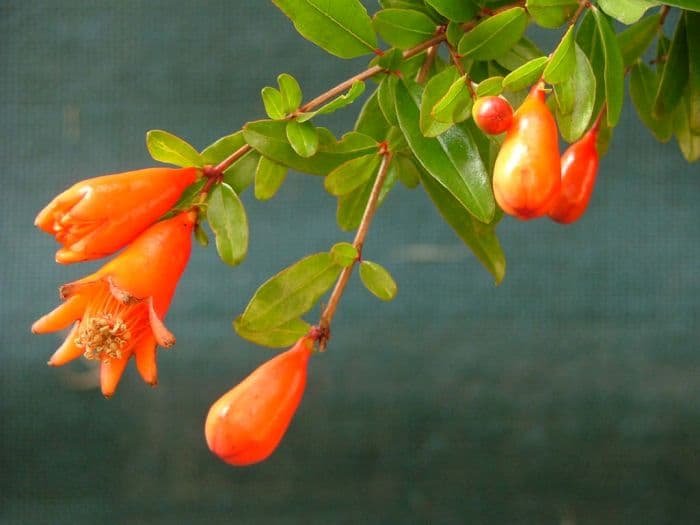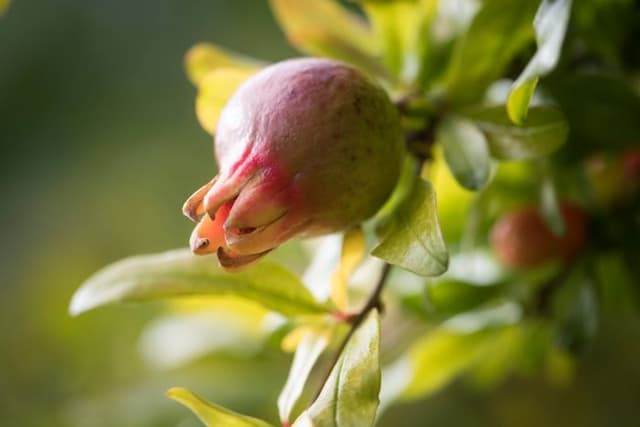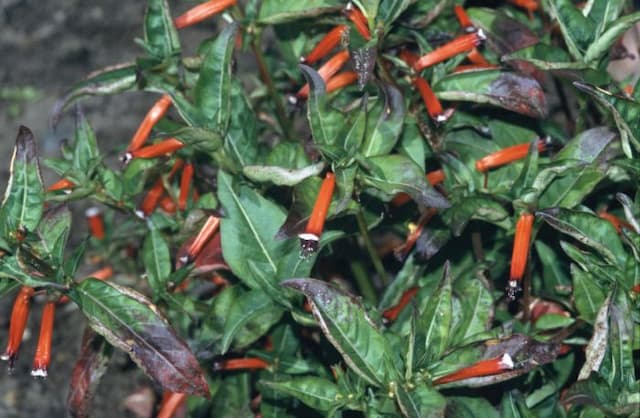Pomegranate Punica granatum

ABOUT
The plant known by the common name pomegranate is a fruit-bearing deciduous shrub or small tree. Its appearance is quite distinctive due to several key features. The leaves of pomegranate are glossy, narrow, and oblong, typically a deep green color that gives a lush look to the foliage. During the blooming season, the pomegranate is adorned with vibrant flowers. These flowers are large, showy, and can range in color from a bright red to a more subdued orange, sometimes even having a white hue. The fruit of the pomegranate plant is a particularly noteworthy feature. The fruits are round, with a tough, leathery skin that can vary in color from red to a rich, reddish-brown. Inside, the fruit is filled with numerous seeds, each surrounded by a juicy, ruby-red aril that is both sweet and tart to taste. The overall appearance of the pomegranate fruit, with its multiple seed chambers partitioned by thin white membranes, is quite unique and distinguishes it from other fruits. The bark of the pomegranate tree is distinctive as well, being brownish-gray and often becoming gnarled and twisted as the plant matures, giving it a rugged and somewhat ancient appearance.
About this plant
 Names
NamesFamily
Lythraceae.
Synonyms
Pomegranate, Garnet, Granatapfel, Melograno, Melagrana, Grenade, Romã, Anardana.
Common names
Punica florida, Punica nana, Punica spinosa
 Toxicity
ToxicityTo humans
The most common name for Punica granatum is pomegranate. Pomegranate is not considered toxic to humans; in fact, its fruit has numerous health benefits and is widely consumed. However, the rind and other non-edible parts of the plant can cause stomach irritation if ingested in large quantities due to the presence of alkaloids and tannins. Symptoms of consuming large amounts of the plant material might include nausea, vomiting, abdominal pain, or diarrhea. These symptoms are generally not severe, but consuming the non-fruit parts, including seeds and rind, should be done in moderation to avoid potential gastrointestinal upset.
To pets
Pomegranate is the most common name for Punica granatum. Pomegranate is not highly toxic to pets, but it can cause some gastrointestinal distress if ingested. The fruit contains compounds such as tannins and alkaloids that may lead to symptoms like vomiting, diarrhea, and possibly gastrointestinal obstruction if the animal eats the rind or a significant quantity of the fruit and seeds. Generally, small amounts of the fruit's flesh should not be harmful, but it's always best to err on the side of caution and prevent pets from ingesting pomegranate to avoid potential adverse reactions.
 Characteristics
CharacteristicsLife cycle
Perennials
Foliage type
Deciduous
Color of leaves
Green
Flower color
Orange-red
Height
6-10 feet [1.8-3 meters]
Spread
6-10 feet [1.8-3 meters]
Plant type
Shrub
Hardiness zones
7-10
Native area
Iran
Benefits
 General Benefits
General Benefits- High Nutritional Value: Punica granatum, commonly known as pomegranate, is rich in essential vitamins, minerals, and antioxidants, making it a nutritious addition to the diet.
- Hydration: Pomegranates have a high water content, which can help to keep the body hydrated.
- Dietary Fiber: The seeds and pulp provide dietary fiber, which is beneficial for digestive health.
- Versatile Use: Pomegranates can be consumed fresh, as juice, or added to various dishes, providing culinary diversity.
- Ornamental Value: The pomegranate plant can be used as an ornamental shrub or tree, with attractive flowers and fruits that enhance garden aesthetics.
- Drought-Resistant: Pomegranate plants are resilient to arid conditions, making them suitable for xeriscaping and water-efficient gardening.
- Natural Dye: The peel and the fruit juice can be used as a natural dye for fabrics and food products.
- Cultural and Historical Significance: Pomegranates have a storied history and are often associated with tradition, symbolism, and rituals in many cultures.
 Medical Properties
Medical Properties- Antioxidant effects: Punica granatum, commonly known as pomegranate, has been reported to have antioxidant properties, potentially helping to protect cells from damage by free radicals.
- Anti-inflammatory properties: The plant may help reduce inflammation, which is linked to various chronic diseases.
- Antimicrobial activity: Pomegranate extracts have been found to exhibit antimicrobial effects against some bacteria and fungi.
- Cardiovascular health: Consuming pomegranate may have benefits for heart health, such as reducing arterial plaque formation and lowering blood pressure.
- Antidiabetic activity: Some studies suggest that pomegranate might help in managing blood sugar levels in diabetic patients.
- Anticancer potential: There is interest in pomegranate's potential anticancer effects, though more research is needed to confirm these findings.
- Gastroprotective effects: Pomegranate may help to protect the gastrointestinal tract and alleviate symptoms of conditions like ulcerative colitis.
- Dental benefits: The antimicrobial properties of pomegranate may also be beneficial for oral health, potentially reducing the risk of conditions like periodontitis and gingivitis.
- Neuroprotective effects: Some research has suggested that pomegranate might have a protective effect against neurodegenerative diseases.
- Menopausal symptom relief: Pomegranate extract may provide relief from symptoms associated with menopause, such as hot flashes and bone loss.
 Air-purifying Qualities
Air-purifying QualitiesThis plant is not specifically known for air purifying qualities.
 Other Uses
Other Uses- Punica granatum, commonly known as pomegranate, can be used as a natural dye. The rind and flowers can create dyes for fabric and leather.
- The hard wood of the pomegranate tree is valuable for making small handcrafted items including tools, handles, and art pieces.
- Pomegranate peel can be used in compost as a rich source of nutrients for soil amendment and plant growth.
- The dried and crushed pomegranate flowers can be used to create natural colorants for cosmetics and craft projects.
- Leather treated with pomegranate tannins is known to produce high-quality, durable leather goods with a unique finish.
- Pomegranate seeds are used as a spice known as anardana, which is popular in Middle Eastern and South Asian cuisine for flavoring dishes.
- The acidic juice of the pomegranate can serve as a mild cleaning agent for metals, helping to remove oxidation from brass and copper.
- Dry pomegranate skins serve as a fuel source for traditional cooking stoves in areas where the tree is grown.
- In some cultures, the pomegranate is a symbol of prosperity and fertility, used in wedding ceremonies and festive decorations.
- The hollowed-out shell of the pomegranate fruit can be used creatively as a small container or potpourri holder for household fragrance.
Interesting Facts
 Feng Shui
Feng ShuiThe Pomegranate is not used in Feng Shui practice.
 Zodiac Sign Compitability
Zodiac Sign CompitabilityThe Pomegranate is not used in astrology practice.
 Plant Symbolism
Plant Symbolism- Fertility: The Punica granatum, commonly known as the pomegranate, is often associated with fertility due to its abundance of seeds, representing prosperity and future generations.
- Eternal life: In various cultural mythologies, the pomegranate is a symbol of immortality and the eternal cycle of life and death, perhaps because of its long shelf-life and hardy nature.
- Marriage: Some traditions hold the pomegranate as a symbol of marital bliss and conjugal fidelity, with the numerous seeds signifying the many possible offspring and the enduring bond of the union.
- Wealth and Abundance: The copious amount of seeds in a pomegranate also represents wealth, abundance, and blessings, as it suggests a rich and bountiful yield.
- Resurrection and New Beginnings: In some stories and artworks, especially those from the Christian tradition, the pomegranate symbolizes resurrection and new beginnings, linked to its seasonal renewal and the story of Christ’s resurrection.
 Water
WaterThe Pomegranate Tree (Punica granatum) prefers deep watering approximately once a week during the growing season, with a reduction to once every two or three weeks in the dormant winter period. It is vital to avoid waterlogging, so ensure the soil is well-draining. Water the tree with about 2 gallons per session for young trees, increasing to 4-6 gallons for mature trees, depending on the size and soil conditions. During hot, dry periods, additional water may be required to keep the soil evenly moist but not saturated.
 Light
LightPomegranate Trees thrive best in full sun conditions, with at least 6 to 8 hours of direct sunlight each day. Place the Pomegranate Tree in a spot where it will receive ample sunlight throughout the day, as this is essential for fruit production and the overall health of the tree.
 Temperature
TemperaturePomegranate Trees prefer warm temperatures and are hardy in USDA zones 7-10; they can survive temperatures as low as 10 degrees Fahrenheit but this may damage the plant. The ideal temperature range for a Pomegranate Tree is between 40 and 90 degrees Fahrenheit, where they can flourish and produce fruit.
 Pruning
PruningPrune Pomegranate Trees to remove dead or damaged branches, to shape the tree and to encourage fruit production. Pruning should occur in late winter or early spring before new growth begins. Prune annually, focusing on opening up the tree's canopy for sunlight and air penetration.
 Cleaning
CleaningAs needed
 Soil
SoilPomegranate plants prefer a well-draining soil mix with a pH between 5.5 and 7.0. An ideal mix can be made from equal parts loam, peat, and coarse sand or perlite. Ensuring good drainage helps prevent root rot and supports healthy growth.
 Repotting
RepottingPomegranates or Punica granatum should be repotted every 3-4 years when grown in containers. Younger plants may require more frequent repotting, especially if they're rapidly outgrowing their current pot. Spring is the ideal time for repotting.
 Humidity & Misting
Humidity & MistingPomegranates thrive in average home humidity levels, but they can tolerate a range. Since they are relatively adaptable, maintaining a typical indoor humidity between 40-60% will suffice for these plants.
 Suitable locations
Suitable locationsIndoor
Place in bright sunlight, maintain 65-75°F, and allow soil to dry out.
Outdoor
Full sun, well-drained soil, water deeply but infrequently.
Hardiness zone
7-10 USDA
 Life cycle
Life cyclePunica granatum, commonly known as pomegranate, begins its life as a seed which, once sown and in favorable conditions, will germinate after approximately 1-6 weeks. The seedling then grows into a shrub or small tree, which can take several years to reach maturity and start bearing fruit. Flowering typically occurs from spring to early summer, with the plant producing bright red, white, or variegated flowers that are attractive to pollinators. After pollination, the flowers develop into the characteristic large, rounded fruits with thick, leathery rinds, which take about 6-7 months to mature. Each fruit contains numerous seeds surrounded by juicy, edible arils. Pomegranates have a relatively long lifespan and can produce fruit for decades with proper care and climatic conditions.
 Propogation
PropogationPropogation time
Spring-Early Summer
The most popular method of propagation for Punica granatum, commonly known as pomegranate, is through hardwood cuttings. This practice is best done in winter when the tree is dormant. Cuttings should be about 10 to 20 inches long (25 to 50 centimeters) and contain at least three sets of buds. The lower end of the cutting should be dipped in rooting hormone to encourage root growth and then planted in a well-draining soil mix. The cuttings need to be kept moist and ideally in a warm environment until roots develop, which can take several weeks to a few months. Once the cutting has established a healthy root system, it can be planted into the ground or into a larger pot to continue growing into a mature pomegranate tree.




